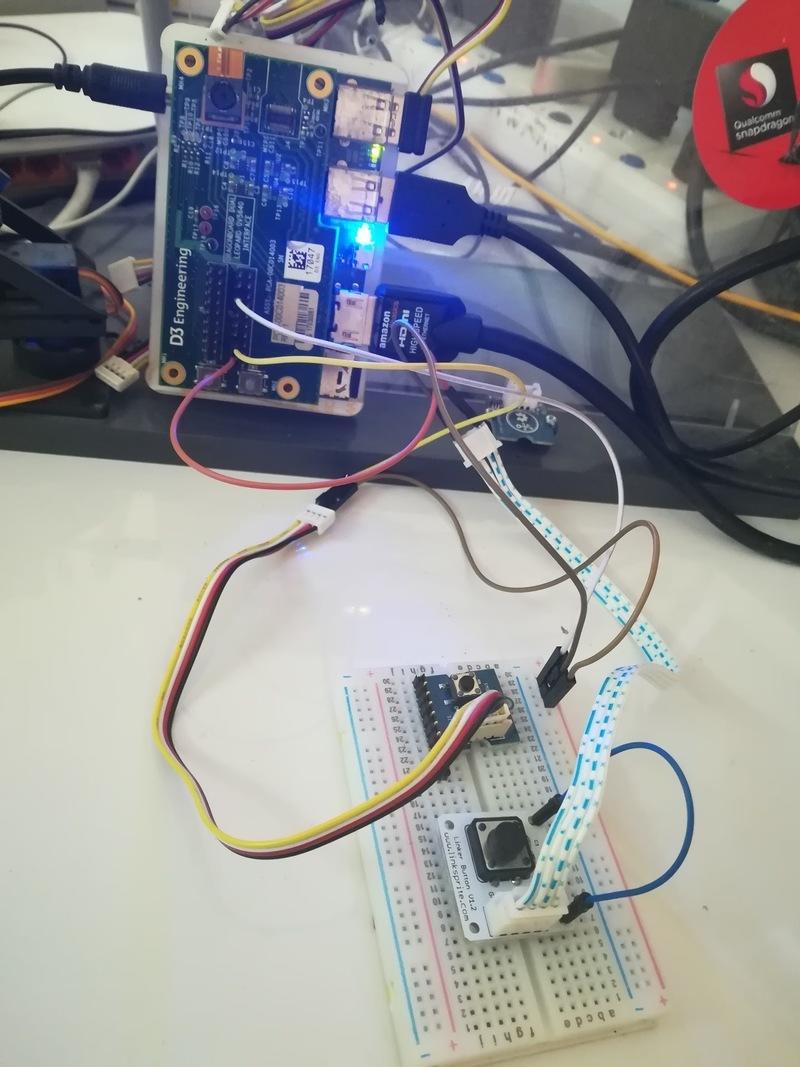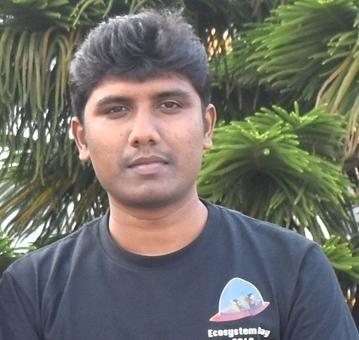Introduction
Hello and Welcome to the Part 2 blog of 96Boards Photobooth project. In this blog we will see how to apply snapchat like filters using OpenCV and 96Boards watermark to the image captured using Photobooth.
Before going further, here is the quick recap of what happened in the previous blogs of this project:
-
Introducing 96Boards Photobooth - This is the introductory blog for the 96Boards Photobooth project which introducted the project, roadmap and bill of materials.
-
Part 1 - 96Boards Photobooth - This blog provided the instructions for setting up OpenCV on Dragonboard410c and capturing the image using OV5640 camera sensor interfaced using D3 Camera Mezzanine.
Hardware Setup
Part 2 is focussed on applying snapchat like filters using OpenCV and a 96Boards watermark at the bottom of the image. Before that, we need to setup the hardware for accomplishing the task. Comparing the previous blog, we need to connect an extra push button to GPIO 25. This push button will be used for scrolling through different overlays.
On a short note, we need the following connections on Dragonboard410c:
(HDMI) 1. Dragonboard410c ---------> Touchscreen LCD
(LS-HS) 2. Dragonboard410c ---------> D3 Camera Mezzanine (OV5640)
(GPIO24) 3. Dragonboard410c ---------> Push Button 1
(GPIO25) 4. Dragonboard410c ---------> Push Button 2

Software Setup
On the software side, we need to install few python libraries in addition to the ones mentioned in previous blog.
$ sudo apt-get update
$ sudo apt-get install python3
$ sudo apt-get install python3-pip
$ sudo pip3 install pillow
From the above mentioned packages, you can see that we will be using Python3 this time.
Part 2 - 96Boards Photobooth
Once both hardware and software setups are done, we can proceed to run the python script for applying overlay filters and saving the image with 96Boards watermark. For the overlay filters, download the following images and save them in the same directory where you would save the python script.
After downloading the above images, save and execute the following python script:
import numpy as np
import cv2
import time
import os
import mraa
import imutils
import _thread
from PIL import Image
pressed = False
capture = True
filter_opt = 1
# Initialize V4l2 with CSI interface
os.system("v4l2-ctl -d /dev/video0")
# Initialize video capture for OpenCV
cap = cv2.VideoCapture(0)
# Create main window
cv2.namedWindow('96Boards Photobooth', cv2.WINDOW_NORMAL)
cv2.resizeWindow('96Boards Photobooth', 800, 480)
#Load filter
filter_1 = cv2.imread('moustache.png')
filter_2 = cv2.imread('cowboy_hat.png')
filter_3 = cv2.imread('test.png')
watermark = Image.open('watermark.png')
# Load classifier
detector=cv2.CascadeClassifier('haarcascade_frontalface_default.xml')
def put_moustache_filter(mst, frame, x, y, w, h):
face_width = w
face_height = h
mst_width = int(face_width*0.4166666)+1
mst_height = int(face_height*0.142857)+1
mst = cv2.resize(mst,(mst_width,mst_height))
for i in range(int(0.62857142857*face_height),int(0.62857142857*face_height)+mst_height):
for j in range(int(0.29166666666*face_width),int(0.29166666666*face_width)+mst_width):
for k in range(3):
if mst[i-int(0.62857142857*face_height)][j-int(0.29166666666*face_width)][k] <235:
frame[y+i][x+j][k] = mst[i-int(0.62857142857*face_height)][j-int(0.29166666666*face_width)][k]
return frame
def put_hat_filter(hat, frame, x, y, w, h):
face_width = w
face_height = h
hat_width = face_width+1
hat_height = int(0.35*face_height)+1
hat = cv2.resize(hat,(hat_width,hat_height))
for i in range(hat_height):
for j in range(hat_width):
for k in range(3):
if hat[i][j][k]<235:
frame[y+i-int(0.25*face_height)][x+j][k] = hat[i][j][k]
return frame
# Helper sub-routine to add text to a frame
def putText(frame, text):
color = (255, 255, 255)
font = cv2.FONT_HERSHEY_SIMPLEX
textsize = cv2.getTextSize(text, font, 1, 2)[0]
x_pos = (frame.shape[1] - textsize[0]) / 2
y_pos = (frame.shape[0] + textsize[1]) / 2
cv2.putText(frame, text, (int(x_pos), int(y_pos)), font, 1, color, 2)
def capture_and_show(text, x, y):
global capture
count = 0
ret, frame = cap.read()
frame = imutils.resize(frame, width=500)
gray = cv2.cvtColor(frame, cv2.COLOR_BGR2GRAY)
faces = detector.detectMultiScale(gray, 1.1, 5, minSize=(40,40), flags=cv2.CASCADE_SCALE_IMAGE)
for (x, y, w, h) in faces:
if filter_opt == 1:
frame = put_moustache_filter(filter_1, frame, x, y, w, h)
if filter_opt == 2:
frame = put_hat_filter(filter_2, frame, x, y, w, h)
# Once countdown is over, store the captured image
if capture == True:
cv2.imwrite("captured/user_" + str(count) + "_captured" + ".jpg", frame)
# Apply 96Boards watermark to the captured image
apply_watermark(count)
count += 1
capture = False
cv2.imshow('96Boards Photobooth', frame)
# Helper sub-routine to apply watermark to the captured image
def apply_watermark(count):
global watermark
base = Image.open("captured/user_" + str(count) + "_captured" + ".jpg")
if base.mode != 'RGBA':
base = base.convert('RGBA')
layer = Image.new('RGBA', base.size, (0,0,0,0))
position = (base.size[0] - watermark.size[0], base.size[1] - watermark.size[1])
layer.paste(watermark, position)
Image.composite(layer, base, layer).save("final/user_" + str(count) + ".png")
def capture_callback(capture_btn):
global pressed
pressed = True
def filter_callback(filter_btn):
global filter_opt
filter_opt += 1
if filter_opt > 2:
filter_opt = 1
def countdown(thread, lock):
lock.acquire()
global pressed
global capture
# Create a new window for countdown
cv2.namedWindow('Countdown', cv2.WINDOW_NORMAL)
cv2.moveWindow('Countdown', 300, 140)
cv2.resizeWindow('Countdown', 150, 150)
font = cv2.FONT_HERSHEY_SIMPLEX
# Give some time for window to initialize
time.sleep(1)
for x in range(5, 0, -1):
# Create a black image
img = np.zeros((150,150,3), np.uint8)
# Display the countdown
putText(img, str(x))
cv2.imshow('Countdown', img)
cv2.waitKey(20)
time.sleep(1)
# Create a dummy black image
img = np.zeros((150,150,4), np.uint8)
putText(img, "CHEESE")
cv2.imshow('Countdown', img)
cv2.waitKey(20)
time.sleep(1)
cv2.destroyWindow('Countdown')
capture = True
lock.release()
# Initialize Capture button
capture_btn = mraa.Gpio(24)
capture_btn.dir(mraa.DIR_IN)
capture_btn.isr(mraa.EDGE_RISING, capture_callback, capture_btn)
# Initialize Filter button
filter_btn = mraa.Gpio(27);
filter_btn.dir(mraa.DIR_IN)
filter_btn.isr(mraa.EDGE_RISING, filter_callback, filter_btn)
while 1:
lock = _thread.allocate_lock()
# Show live preview
capture_and_show("TAKE", 220, 180)
if pressed==True:
pressed = False
_thread.start_new_thread(countdown, ("Countdown-Thread", lock,))
if cv2.waitKey(1) & 0xFF == ord('q'):
break
# Do cleanup
cap.release()
cv2.destroyAllWindows()
Above python script can be executed using the following command:
$ sudo python3 photobooth.py
Note: You need to execute the media pipeline instructions mentioned in the previous blog before executing the python script.
Video Demonstration
Conclusion
So we are at the end of this Part 2 - 96Boards Photobooth blog. Some of the code I have used in this part has been derived from the following work done by fellows from Redhat and Kunal Gupta.
[1] Watermark - https://github.com/lmacken/photobooth.py [2] Overlay Filters - https://github.com/kunalgupta777/OpenCV-Face-Filters
I’d like to thank both of them and since I have used their code, the final source code of this project will be hosted with GPL v3 license on our 96Boards Projects Org, complying to the license of the previous works.
In the next part, we will see how to upload the captured images to cloud and provide some options for the user to download it.







